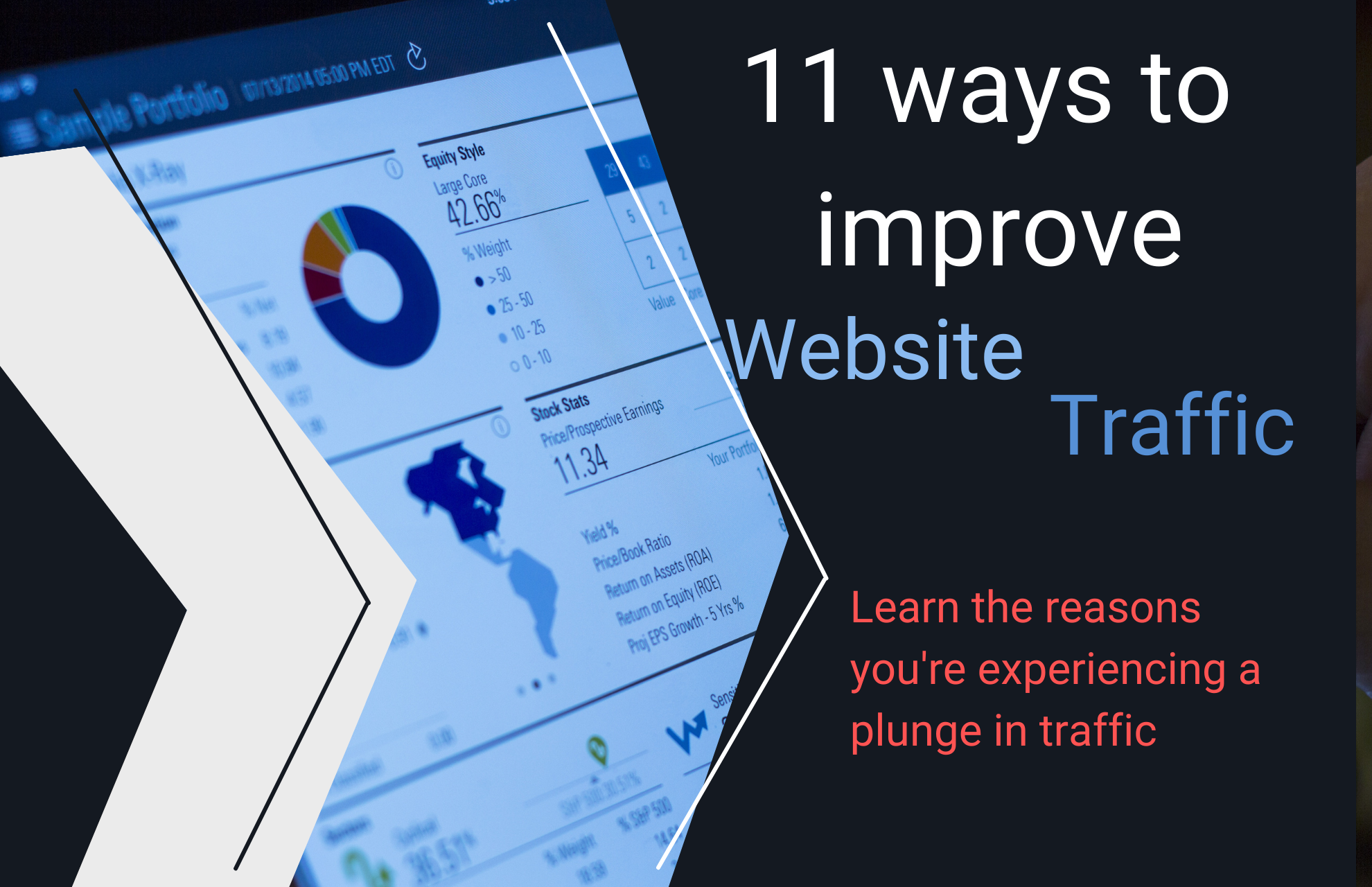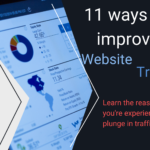
O Driving traffic to your website is essential for online success. In this article, we want to help ambitious website owners with proven techniques to boost website visits to the next level, backed by legitimate examples. By implementing these strategies, you will see improvement in your website’s online presence and reach a wider audience.
When you experience a plunge in traffic, have you ever tried potential reasons behind it?
If not, here are a few reasons why websites endure poor website traffic:
- Poor search engine optimization (seo): websites that are not optimized for search engines and audience experience may rank lower in search results, leading to reduced organic traffic. Factors like relevant keywords, site structure, page speed, core web vitals, security, etc play a crucial role in seo.
- A study by ahrefs found that 90.63% of pages in their index received no search traffic from google, highlighting the importance of seo in driving organic traffic (source: https://ahrefs.com/blog/seo-stats/)
- Low-quality content: websites with low-quality, outdated, or irrelevant content are less likely to attract and retain visitors. High-quality, engaging content is essential to keep users on the site and encourage them to share it, leading to increased traffic.
Content quality: a survey by hubspot revealed that 43% of people admitted to skimming blog posts, emphasizing the need for engaging and high-quality content (source: https://www.hubspot.com/marketing-statistics). - Over-optimization: Excessive use of exact-match anchor text or aggressive link building can be perceived as over-optimization, which may lead to search engine penalties and lower rankings, causing a decrease in website traffic (source: https://www.searchenginejournal.com/anchor-text-optimization/).
- Poor backlink strategy: A poor backlink strategy can lead to a drop in website traffic due to several factors. Low-quality backlinks from spammy or unrelated websites can negatively impact your search engine rankings, as search engines consider these links unnatural and potentially harmful. Additionally, engaging in manipulative link-building practices can result in Google penalties, such as those enforced by the Penguin algorithm, further affecting your site’s rankings and organic search traffic. To maintain and increase website traffic, it’s essential to focus on a healthy backlink strategy that involves acquiring high-quality, relevant, and natural backlinks from authoritative sources.(Source: https://www.searchenginejournal.com/low-quality-links/239943/).
(Source: https://www.searchenginejournal.com/google-penalty-recovery/196195/)
(Source: https://www.searchenginejournal.com/link-building-guide/relevant-irrelevant-backlinks/) - Lack of promotion on social channels: Merely producing content is not enough; websites must actively promote their content through various channels, such as social media, email marketing, and influencer outreach. A lack of promotion can result in content not reaching the target audience.
- Slow page load times: slow-loading websites can frustrate users and lead them to abandon the site, resulting in lower traffic. Optimizing page load times is essential for a better user experience and improved search engine rankings.
- Page load times: according to a study by google, 53% of mobile site visitors left a page that took longer than three seconds to load (source: https://www.thinkwithgoogle.com/marketing-strategies/app-and-mobile/mobile-page-speed-new-industry-benchmarks/).
- Poor user experience (ux) and design: a poorly designed website with confusing navigation or cluttered layout can deter users from staying on the site. An attractive, user-friendly design is vital to keep users engaged and encourage them to explore the site further.
User experience: a study by forrester found that a well-designed user interface could raise a website’s conversion rate by up to 200% (source: https://www.forrester.com/report/forresters+top+10+best+practices+for+web+design/-/e-res56719). - Ineffective keyword targeting: focusing on the wrong keywords or not conducting proper keyword research can lead to propel in the wrong direction end up with reduced visibility in search engine results, resulting in lower traffic.
- Limited or no social media presence: Social media platforms are a significant source of referral traffic. Websites that do not maintain an active presence on social media may miss out on opportunities to connect with their audience and drive traffic to their site. Your website loose opportunities to gain credibility to your researched content.
- Neglecting mobile users: With the increasing number of users browsing the internet on mobile devices, websites that are not mobile-friendly or responsive can struggle to attract and retain mobile users, leading to reduced traffic.
- Mobile friendliness: according to Google’s mobile playbook, 57% of users said they wouldn’t recommend a business with a poorly designed mobile site (source: https://www.thinkwithgoogle.com/marketing-strategies/app-and-mobile/the-mobile-playbook/)
In today’s digital age, website traffic is a crucial component of a successful business that drives revenue growth. Many webmasters and companies grapple with increasing website traffic even when implementing comprehensive digital marketing services. According to surveys from Think with Google, HubSpot, and Ahrefs, the issue is that many companies are unsure of where to begin, leading them to try a range of ineffective techniques that either don’t work or produce short-lived results.
The challenge of boosting website traffic is a pressing concern for proactive and ambitious businesses striving for sustainability. It’s not surprising that companies are keen to increase their website traffic, as it is a key factor in expanding their business and boosting revenue. Now, let’s explore some insightful research that reveals numerous companies are struggling to enhance website traffic and have prioritized it as their primary objective.
According to a report by ahrefs, 90.63% of pages in their index get no search traffic from google (source: https://ahrefs.com/blog/seo-stats/). This statistic highlights the importance of seo and the struggle of many websites to attract organic search traffic.
In a study by hubspot, it was found that 61% of marketers cited generating traffic and leads as their top marketing challenge (source: https://www.hubspot.com/marketing-statistics).
A survey by clutch revealed that 29% of small businesses still did not have a website, indicating a gap in online presence (source: https://clutch.co/web-developers/resources/small-business-website-2017).
According to the content marketing institute, 91% of b2b marketers use content marketing to reach customers, highlighting the importance of content in driving website traffic (source: https://contentmarketinginstitute.com/wp-content/uploads/2018/10/2019_b2b_research_final.pdf).
Here are legitimate ways to increase traffic from Google, social channels, etc.
Understand the trends and demand in your targeted audience with keyword researching:
Keyword research is a crucial aspect of any successful website strategy. By identifying high search volume keywords, you will learn there is a significant for your offering and you can plan content topics that cater to your audience’s interests.
A study by Ahrefs revealed that targeting the right keywords can increase organic search traffic by up to 92.42% (source: https://ahrefs.com/blog/keyword-research/).
Keyword research helps you uncover the terms and phrases your target audience uses when searching for products or services similar to your offering. This insight can help you tailor your messaging and content to better address their needs, concerns, and preferences, ultimately improving your chances of success.
Use tools like google keyword planner, ahrefs, or semrush to find high search volume keywords relevant to your niche. Incorporate these keywords naturally into your content, and other digital assets, the organic traffic will follow.
Basically, keyword researching gives you confidence that all your digital marketing efforts to drive traffic will not go in vain.

Strategize brand messaging that helps position your website in a competitive niche
A strong brand message is important because it helps you to define your business, set expectations, and communicate with customers. A brand message should be concise and memorable, but also something that can be used across all marketing channels (source: https://www.forbes.com/sites/forbesagencycouncil/2017/07/25/finding-brand-purpose/#5e8f6ed95d6a).
Identify your unique selling proposition (usp) and craft a clear, consistent message that communicates your brand’s values, personality, and benefits your target audience. It is important to note that brand message should be memorable and easily digestible by your targeted audience. Ensure this message is consistently portrayed across all channels and touchpoints. It can be delivered through various channels, including social media posts, email marketing campaigns, website content and product descriptions. Once you have established your brand’s USP and message, it is important to ensure that every piece of marketing collateral, articles and posts reflects this messaging and reinforces your brand identity.
Developing a unique and compelling brand message is essential to differentiate your website from competitors. A strong brand message can lead to increased consumer trust and loyalty, ultimately driving more traffic to your site (source: https://www.forbes.com/sites/forbesagencycouncil/2017/07/25/finding-brand-purpose/).
Build content marketing strategy and calendar
A well-crafted content marketing strategy can strategically target your audience, ensuring that you consistently publish fresh and valuable content to gain top rankings and traction.
After finalizing compelling brand messaging to position your brand, the next step is to create a content strategy. Having a content marketing strategy and calendar ensures a consistent flow of high-quality content that attracts and retains visitors. According to the Content Marketing Institute, 60% of the most effective marketers have a documented content marketing strategy (source: https://contentmarketinginstitute.com/2015/10/content-marketing-research-b2b/).
By addressing the needs, interests, and pain points of your target audience, you can boost website visits, engage your visitors, and ultimately increase conversions and customer loyalty. Develop a content plan that outlines the topics, formats, and publishing frequency of your content. Use an editorial calendar to schedule content creation and publication, ensuring a consistent flow of fresh content that caters to your audience’s needs and interests.
Publishing new content regularly is crucial for staying relevant and competitive, as search engines like Google favor websites that are active and up-to-date. Fresh content can help improve your search engine rankings, leading to increased organic traffic, thus allowing your content marketing strategy to effectively reach and engage your target audience.
Map your content strategy to buyer journey
Aligning your content strategy with the different stages of the buyer journey can help to drive website visits by providing targeted, relevant information at each stage. This approach has been shown to increase conversion rates and improve user experience (source: https://www.hubspot.com/marketing-statistics)
Create content tailored to each stage of the buyer’s journey (awareness, consideration, and decision). Address the specific pain points, questions, and concerns of your audience at each stage to guide them through the conversion process.
SEO website
- Optimize the whole website including landing pages:
Website optimization is essential for increasing organic search traffic. According to moz, properly optimized landing pages can increase conversion rates by up to 25% (source: https://moz.com/blog/why-arent-you-optimizing-for-voice-search). Optimize your website by incorporating target keywords in page titles, meta descriptions, header tags, and content. Improve site structure, internal linking, and page load times to enhance search engine crawlability and user experience. Local seo:
Focusing on local seo can help businesses attract more customers from their local area. A study by brightlocal found that 97% of consumers search online for local businesses (source: https://www.brightlocal.com/research/local-consumer-review-survey/). Pptimize your Google my business listing, include location-specific keywords, and acquire local citations and reviews to improve local search visibility.
Fix UI/UX issues to increase website visits
A well-designed user interface and user experience can significantly improve website traffic. Forrester found that improving ui/ux can raise conversion rates by up to 200% (source: https://www.forrester.com/report/forresters+top+10+best+practices+for+web+design/-/e-res56719)
Evaluate your website’s user interface and user experience by analyzing site navigation, layout, and responsiveness. Conduct user testing, gather feedback, and make necessary improvements to enhance usability and user satisfaction.
Ensure your website is mobile-first index
A mobile-friendly website is crucial to attract and retain mobile users. Google’s mobile playbook states that 57% of users wouldn’t recommend a business with a poorly designed mobile site (source: https://www.thinkwithgoogle.com/marketing-strategies/app-and-mobile/the-mobile-playbook/).
Ensure your website is responsive and optimized for mobile devices. Test your site on various screen sizes and devices and implement a mobile-friendly design that offers a seamless user experience.
Overhaul posts with poor engagement rate leveraging google search console
Revamping underperforming content can help to increase website visits. Google search console is a valuable tool to identify and improve content with low engagement rates (source: https://search.google.com/search-console/about)
Identify underperforming content using google search console and update it with fresh information, improved visuals, and better keyword targeting. Republish and promote the revamped content to attract new visitors.
In following video, Google’s John Mueller suggests to improve old content for audience.
Analyze user-behavior flow in Google Analytics to spot content funnel issues
Google analytics can help identify issues in your content funnel, enabling you to optimize your website for better user experience and increased traffic (source: https://analytics.google.com/analytics/academy/course/6).
By analyzing user-behavior flow, you can pinpoint and resolve bottlenecks, keeping visitors engaged and moving through the conversion process.
Use Google Analytics to monitor user interactions with your website, identify bottlenecks in your content funnel, and make necessary adjustments to improve engagement and conversions.
Quick tutorial to set up User ID tracking on G4
Mastering Mindshare: Boost Awareness with How-to Guide Content in Email Marketing
Incorporating engaging how-to guides in your email marketing campaigns can elevate your brand’s visibility and attract more visitors to your website. Campaign Monitor reveals that relevant, informative emails can boost click-through rates by 14% and conversion rates by 10% (source: https://www.campaignmonitor.com/resources/guides/email-marketing-benchmarks/).
Craft informative how-to guides that cater to your audience’s needs and address their challenges. Integrate these guides into your email marketing efforts, nurturing leads with valuable, actionable content that effectively drives traffic to your website.
Skyrocket visits from social media channels (influencers collaboration, participating in trending discussions, share creative posts)
Leveraging social media can significantly boost website visits. Collaborating with influencers, participating in trending discussions, and sharing creative content can help attract more visitors to your site. A study by sprout social found that 74% of consumers rely on social media to make purchasing decisions (source: https://sproutsocial.com/insights/data/q3-2016/).
Collaborate with influencers who resonate with your target audience, participate in trending discussions relevant to your niche, and share creative, engaging content on your social media channels to attract more website visitors.
Author


